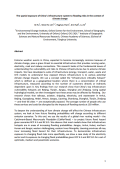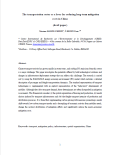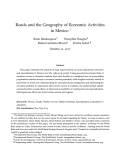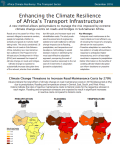
Extreme weather events in China, expected to become increasingly common because of climate change, pose a grave threat to essential infrastructure that provides running water, electricity, road and railway connections. This research looks at the fundamental issues of understanding the vulnerability and risks to Chinese infrastructures due to adverse climate impacts. The authors have developed a suite of infrastructure (energy, transport, water, waste and ICT) models to understand how exposed China's infrastructure is to various potential climate change impacts. A concept called the “infrastructure criticality hotspot” is used which is defined as a geographical location where there is a concentration of critical infrastructure, measured according to the number of customers directly or indirectly dependent upon it. Key findings from this research show that China’s top infrastructure vulnerability hotspots are Beijing, Tianjin, Jiangsu, Shanghai and Zhejiang. Using spatial hydrological models, the authors then investigate how these areas may be affected by flooding.

Chinese transport activity has grown rapidly in recent years, and curbing CO2 emissions from this sector is a major challenge. This paper investigates the potentials offered by both technological solutions and changes in infrastructure deployment strategy that can address this challenge. The research is carried out by using the IMACLIM-R energy-economy-environment (E3) model which includes a detailed description of passenger and freight transportation dynamics. The standard representation of transport technologies is supplemented with an explicit representation of the “behavioral” determinants of mobility. Although they drive transport demand, these determinants are often disregarded in mitigation assessments. This framework considers (i) the spatial organization of housing and production, (ii) modal choices induced by transport infrastructures and (iii) the freight transport intensity of production and distribution processes.

This paper estimates the impacts of road improvements on local employment structure and specialization in Mexico over the 1985-2016 period. Using geo-referenced panel data, it measures access to domestic markets from each locality as a weighted sum of surrounding populations (market access) or incomes (market potential), with weights inversely related to travel time or travel cost. Instrumenting for road placement endogeneity and addressing the recursion problem in regressions that involve access to markets, the analysis finds significant and positive causal effects of improved accessibility on employment and specialization. Heterogeneous effects are found across sectors and regions.

Road construction is thought to result in forest loss, but causal identification has been elusive. Using multiple causal identification strategies, the authors find that India's rural road construction program, which built new feeder roads to over 100,000 villages and 100 million people, had precisely zero effect on local deforestation. In contrast, when 10,000 kilometers of India's national highway network were upgraded, there was substantial forest cover loss, driven by increased timber demand along the highway corridor. In terms of forests, last mile connectivity had a negligible environmental cost, while expansion of major corridors had important environmental impacts.

Roads are a key asset for Africa - they connect villages to economic centers, people to hospitals, children to schools and goods to markets facilitating trade. This study considered 2.8 million km of roads in Sub-Saharan Africa, including new road construction outlined in the Programme for Infrastructure Development in Africa (PIDA) and assessed the impact of climate change on roads and bridges. Climate change is expected to substantially increase disruption time of the network, shorten their rehabilitation life-cycle, and increase repair and rehabilitation costs. The study evaluates the economics of engineering solutions to build resilience to climate change impacts due to flooding, precipitation, and temperature and develops a methodology to assist decision makers in identifying the most cost-effective adaptation approach, comparing the cost of inaction (reactive response) to the net cost of investments in adaptation (proactive adaptation).
Key Messages:
